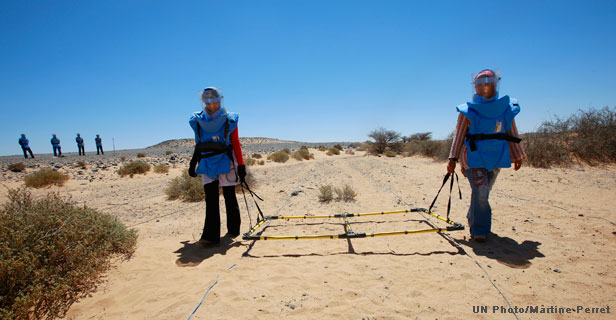
Mine action entails more than removing landmines from the ground. It also includes a full range of services aimed at eliminating threats and helping the people who have fallen victim to them. Affected states, with the support of the international community, have achieved real progress in addressing the threat of mines and explosive remnants of war, or ERWs, including cluster munitions.
In many countries ERW pose an even greater threat to people's safety than landmines. ERW comprises unexploded ordnance-bombs, mortars, grenades, missiles, cluster munitions or other devices that fail to detonate on impact but remain volatile and can kill if touched or moved-and abandoned explosive ordnance.
There are five components or "pillars" of mine action:
Mine action is evolving. Mine action actors - UN and partners alike - are increasingly requested to respond to the security and humanitarian hazards posed by various explosive devices by providing assistance, such as weapons and ammunition stockpile security, management and destruction, IED risk and awareness training, and armed violence reduction.
Primary responsibility for mine action lies with the governments of mine-affected countries which receive assistance from the United Nations. There are 14 UN departments, programmes, funds and agencies that provide various types of services. Some of these UN bodies target their services to a particular group of people, such as refugees, or to a special circumstance, such as a humanitarian crisis, and still others focus on a particular pillar of mine action.
The vision of the United Nations is a world free of the threat of mines and explosive remnants of war (ERW), including cluster munitions, where individuals and communities live in a safe environment conducive to development and where the human rights and the needs of mine and ERW victims are met and survivors are fully integrated as equal members of their societies.
The United Nations works with affected states to reduce the threat and impact of mines and ERW, including cluster munitions, on peace and security, humanitarian relief, human rights, and socio-economic development; It does so in partnership with civil society, the private sector, international and regional arrangements, and donors with an aim to secure levels of prevention and protection for individuals and communities, at which point UN mine action assistance is no longer requested.